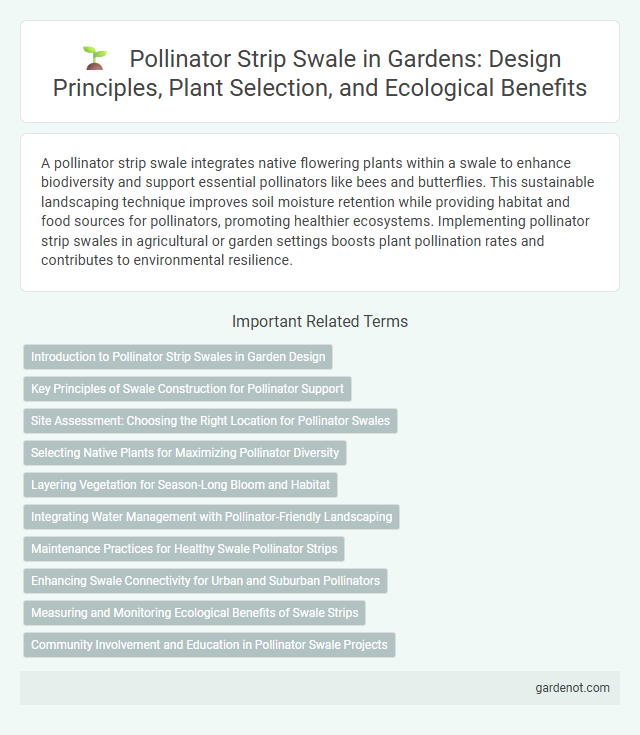A pollinator strip swale integrates native flowering plants within a swale to enhance biodiversity and support essential pollinators like bees and butterflies. This sustainable landscaping technique improves soil moisture retention while providing habitat and food sources for pollinators, promoting healthier ecosystems. Implementing pollinator strip swales in agricultural or garden settings boosts plant pollination rates and contributes to environmental resilience.
Introduction to Pollinator Strip Swales in Garden Design
Pollinator strip swales integrate water management with habitat creation by combining shallow drainage channels and dense plantings of native flowering species that attract bees, butterflies, and other pollinators. These swales improve soil moisture retention and reduce runoff while supporting biodiversity and enhancing garden resilience. Implementing pollinator strip swales in garden design promotes sustainable ecosystems and strengthens pollination services crucial for fruit and vegetable production.
Key Principles of Swale Construction for Pollinator Support
Swale construction for pollinator support emphasizes gentle slopes and dense vegetation with native flowering plants to maximize water infiltration and habitat value. Incorporating a diverse mix of nectar-rich blooms ensures continuous forage availability for pollinators throughout the growing season. Proper soil composition and organic matter enhance microbial activity, promoting healthy plant growth and resilient ecosystems in pollinator strip swales.
Site Assessment: Choosing the Right Location for Pollinator Swales
Site assessment for pollinator strip swales involves evaluating soil type, sunlight exposure, and existing vegetation to ensure optimal plant growth and pollinator attraction. Selecting locations with well-drained soil and at least six hours of daily sunlight maximizes the viability of native flowering plants. Proximity to water sources and minimal disturbance from foot traffic also enhance habitat suitability for pollinators.
Selecting Native Plants for Maximizing Pollinator Diversity
Selecting native plants for a pollinator strip swale enhances local biodiversity by providing essential nectar and pollen sources tailored to the needs of indigenous pollinators like bees, butterflies, and hummingbirds. Native plant species such as Echinacea purpurea, Asclepias tuberosa, and Monarda fistulosa support a wide range of pollinator species while requiring less maintenance and water than non-native plants. Implementing a diverse plant palette that blooms sequentially throughout the growing season maximizes habitat usability, boosting pollinator activity and ecosystem resilience.
Layering Vegetation for Season-Long Bloom and Habitat
Pollinator strip swales maximize biodiversity by layering vegetation with early, mid, and late-season flowering plants to ensure continuous bloom and habitat availability. Native wildflowers, grasses, and shrubs create structural diversity that supports a wide range of pollinators including bees, butterflies, and hummingbirds. This multi-layered approach enhances ecosystem resilience and promotes effective water infiltration and nutrient cycling within the swale system.
Integrating Water Management with Pollinator-Friendly Landscaping
A pollinator strip swale combines stormwater management with habitat creation by integrating native flowering plants that attract bees, butterflies, and other pollinators. This landscape design enhances water infiltration and reduces runoff while supporting biodiversity and promoting healthy ecosystems. Incorporating these green infrastructure elements improves urban resilience and fosters sustainable environmental practices.
Maintenance Practices for Healthy Swale Pollinator Strips
Regular maintenance of pollinator strip swales involves selective mowing to prevent overgrowth while preserving native wildflowers and nectar sources essential for pollinators. Proper irrigation management ensures optimal soil moisture levels, promoting robust plant health and minimizing weed encroachment. Seasonal monitoring and timely removal of invasive species support biodiversity, enhancing habitat quality for bees, butterflies, and other pollinating insects.
Enhancing Swale Connectivity for Urban and Suburban Pollinators
Pollinator strip swales improve swale connectivity by creating continuous habitats for urban and suburban pollinators, promoting biodiversity and ecosystem resilience. These strips integrate native flowering plants that provide essential nectar and pollen resources, supporting bees, butterflies, and other pollinating insects throughout seasonal cycles. Enhanced connectivity in swale networks facilitates pollinator movement and genetic exchange, which is crucial for sustaining healthy pollinator populations in fragmented landscapes.
Measuring and Monitoring Ecological Benefits of Swale Strips
Pollinator strip swales enhance biodiversity by providing essential habitats and food sources for pollinators, which can be quantitatively assessed through species richness and abundance surveys. Measuring ecological benefits involves monitoring soil moisture retention, nutrient cycling, and pollinator visitation rates using standardized protocols and remote sensing technologies. Data collected supports adaptive management strategies, ensuring swale strips contribute effectively to ecosystem services and agricultural productivity.
Community Involvement and Education in Pollinator Swale Projects
Community involvement in pollinator strip swale projects enhances local biodiversity awareness and fosters stewardship by engaging residents in planting native wildflowers and maintaining habitats. Educational programs focused on pollinator health and ecosystem benefits equip community members with knowledge to support sustainable practices and encourage citizen science monitoring. Partnerships with schools and local organizations amplify impact by integrating hands-on learning and promoting long-term commitment to pollinator conservation.
Pollinator strip swale Infographic

 gardenot.com
gardenot.com